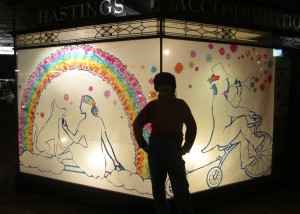 International Tape Art team Erica Duthie and Struan Ashby have been inspiring audiences for over 20 years. They have recently returned from their latest residency at the Blossom Festival in Hastings.
International Tape Art team Erica Duthie and Struan Ashby have been inspiring audiences for over 20 years. They have recently returned from their latest residency at the Blossom Festival in Hastings.
“Creative director Pitsch Leiser asked us to do something that is quite specific to the previous history of the Hastings Blossom Parade,” says Struan. “So we did some research and watched a DVD with images supplied from the Hastings Library. We researched into some of the more interesting floats and are revisiting some of them for the festival”.
Erica adds “What you find in this Hastings Festival is there are floats that people love and they have reconstituted over the years. There is a massive swan that has been very popular so there have been three or four different swans over time.
“There have also been parade favourites which we have been referencing and then putting our own twist on. One of the ones I am working on which I am quite excited about won a parade category which involved a guy in a bath tub on a bicycle. It is really cool. I am going to change it to have a woman on a bike with a Busby Berkeley 1950s swimming cap on. She will be in the bath tub cycling. So that kind of thing will be so much fun.”
In the past Erica and Struan have freestyled a lot but now are finding they enjoy researching their projects.
“More and more we like to spend more time doing research and finding images that are specific to our concept or idea. Even though we free form it on the day quite a lot we are more prepared.
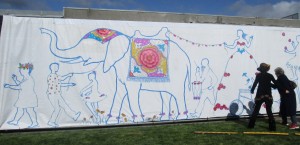 “We have got our interpretation of an elephant in the parade so I have done a big bright cover so he is going to pop out,” says Struan.
“We have got our interpretation of an elephant in the parade so I have done a big bright cover so he is going to pop out,” says Struan.
They both take great pride in interpreting the history of the various communities through their installations.
“We are being entrusted to help share those stories so we need to be very clear that we are doing so with some authenticity and thoughtfulness,” says Erica.
Struan adds “We always have our sort of twist on things. We don’t ever get told what to do or we would never respond that way. If we are given a very open brief we respond in a very playful way but with authenticity.”
Normally only armed with blue masking tape their work is now evolving to include other medias.
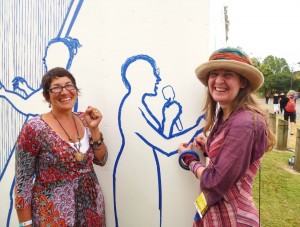
“Having a roll of tape is so much freedom because you can bowl up to a wall and just know that you have to do something. At the moment we are working with all this cellophane and it is actually quite nightmarish of a medium to work with. I have worked with film and various other things sometimes the process can be diabolic,” says Struan.
“We are also becoming prepared with more different kinds of media. We would previously just work with tape but now we are branching out and working with different materials as well. Sometimes we go semi pre-prepared with works like Mandala’s draw on recycled billboard skin or we pre-drew a tractor on billboard skin or as we did at Bangkok we drew on laminated cellophane. So we are drawing pre-prepared to include in the material in a different material. It is not drawn in tape but it is to be included in the tape mural.”
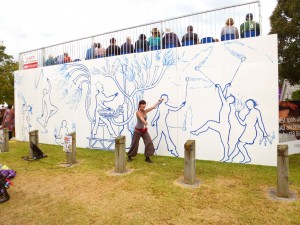
Erica adds “Working with a roll of tape just gives you so much freedom to draw large scale and to draw in public, in places that you would normally never get access to. Also you become a performer and you have to work in public and interact with people and that causes a whole different set of narrative instead of images and dialogue which you would never have if you were just working from home.”
Erica and Struan create learning experiences for themselves as they problem solve and push their limits further while experimenting with different mediums.
“We knew we were going to do a big glass base and have thousands of people and wanted our work to be powerful with back lighting,” explains Erica. “We went oh lets add colour and then we thought oh how do we do that? Let’s try layering cellophane and laminating it. It seemed like a brilliant idea at the time. Little did we know that it wasn’t. Perhaps it was typical of us to use a cheap, simple, accessible medium that is seriously challenging to actually do it on scale.”
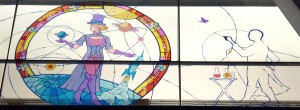
Laughing Struan says “Now we are deciding to do it again and we are revisiting why we found it so difficult the first time.”
Another aspect that the couple are adding to their work is enabling the public to view historic photos and work in progress photos as they create their installations.
“We are actually providing the background so that it is accessible for people to understand what your process is and what your links and inspiration points are,” explains Erica.
“Whether or not you have fine art training or whomever you are you will never have access to the content that will give you the layers of pleasure that you can have if you are not supplied it.
“Because we are public artists our interest is not in speaking and not being understood but rather communicating and connecting to people so we will be writing it in a form that people can understand.”
Another big development for their work is encouraging individuals to discover their talents off the sports field.
“One of the things that is new in the last couple of years is that we have been doing more residencies and more small town projects and we have been loving that. There is a real need for alternatives to sport particularly in the regions, in our esteemed view,” says Erica.
“You need role models and a kind of life line out of the expected norm for those who actually have an amazing place in society but they are just not sure as to what that might be.
“If you don’t see somebody doing something which you can relate to, it is very difficult to image the possibility.”
Every time they put themselves into a public space they are open for critique. They have humorous stories to tell of “getting the picture wrong” along with many of praise and surprise at the realism of the end result.
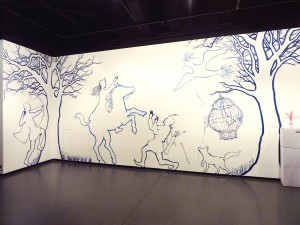
“The work we do is quite realistic so it is all quite narrative, people based and we are drawing quite realistic objects we don’t usually do abstract. So if we do something wrong someone will be there to tell you,” says Struan.
“Then there is the usual story of picking people who will be the portraits. This is the locals who will bring to life the stories by posing for the members of their families.”
Erica loves the thrill of picking people to draw and chooses those with character.
“If a family group comes up and there is a grandmother there I love saying would the grandmother pose? They always put forward the prettiest kid. Some people are just lovely and you know that no-one has honoured them in that way. That is one of the gifts of our process that we can.”
Struan adds “We are quite used to getting quite positive comments you know people wandering by and being quite polite about the thing we do. It is really wonderful having that reinforcement as you work. I think it is rare unless you are actually on the stage performing, dancing or some other conventional performance to get so positive feedback while you are working.”
Erica explains “If we do get critical feedback it is usually from kids who go ‘there should be another line on that string holding the puppet up’. They have looked hard and you realise they did pick up on something that you hadn’t quite picked up on when you were doing it.”
Both Erica and Struan enjoy sharing their innovative side either by creating their installation or sharing their knowledge with others.
“A lot of it is confidence and know how. We have demonstrated that it is quite achievable by teaching and supporting a whole range of people over the world to do it. For some none reason none of them chose to go on and do it for the rest of their lives like us,” says Erica as she starts laughing.
A couple of years ago Erica and Struan had the privilege of celebrating the one year anniversary of the creation of the student volunteer army after the Christchurch earthquake.
“I think that is something that is worth referring to because the nice thing about being a large scale public mural maker is that we tell the story with an ensemble cast.
“It is not just Sam Johnson but it is the many others who are dealing with the statistical planning of how to get the buses across the bridges that were being closed or open. It was all the amazing people that enabled that mural to fly. We in our role now are being asked to come into a community in that kind of way because of the skills that we have to listen to come up with a metaphor that is accessible.”
They also had the privilege of creating a mural with a super group of people with various disabilities from Skill Wise. The mural came about when Erica drew one of the group at a previous festival.
“I drew him juggling. We gave him a short introduction on how to draw with tape. He went away and drew with tape and then the earthquake happened. They couldn’t go back into their space.
“Ben was really upset about it and he bumped into us again a couple of years later at another festival where I drew him again. We talked about how we were going to do a project and I asked him if he would be interested.
“We managed to make it possible for his group to come and do that project for Wellbeing Canterbury with him in particular because of the fact of all the stories over the years. It was just such a great group of people that did some amazing things. We are still in contact with him regularly which is great.”
Spending time around Hospitals and working with people from all walks of life has given Erica and Struan the confidence to take on bigger challenges to engage with those struggling with normal life.
“We said who have you had most trouble connecting with? Where is the greatest need? We like challenging ourselves which means we are getting to be in those more challenging places,” says Erica.
“It is just a real pleasure. You learn a lot when you work with people. We are going up to a disability arts festival in Auckland in a few weeks time. I always come back from there always feeling replenished because of the honesty and the emotional openness from people who have various stormy elements in their physical or emotional makeup. It is just wonderful.”
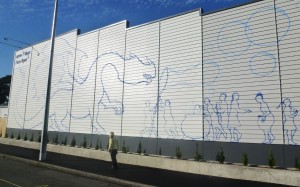 One unusual aspect of Tape Art is that it is temporary. The taking down of the installation causes as much interest and intrigue as does the initial creation.
One unusual aspect of Tape Art is that it is temporary. The taking down of the installation causes as much interest and intrigue as does the initial creation.
“As part of the process at a rip down the family gather around the picture of their loved one, in any culture it happens consistently. They quietly ring that space then take it down and generally take the tape home. It seems really bizarre but is really common,” says Erica.
“Although I think more and more we would respond to that question that we would really like to take it down and have the fun factor of it being a temporary performance. More and more we are actually wanting things to be a bit more permanent which is only something that we have been wanting to do in the last few months,” explains Struan.
Erica says as they now work hard researching their installations and hear the memories that it invokes it is getting harder to take down their day’s creation.
“I suspect that is partially to do with we have been doing so much more background to the work and the works tend to have meaning that is specific to people or a place in a way that might well be useful for them to have and refer to again.
“It is a bit different from having a whimsical moment in time that is just pure kind of responsive to the effort as opposed to something that is really quite grounded in social history or something that is tangible.
“The rare thing about what we do is when a group of kids go racing hands first towards an art work instead of the usual shriek of don’t touch the art – we always tell the parents – you are welcome to come and touch the art work – which really raises eyebrows.
The couple began experimenting drawing with tape when they were both at Art School in Canterbury around 1992.
“It was completely fresh and incredibly unladen. It was the non-preciousness of it, the kinds of accessibility and the unpretentious simplicity of it that appealed to me. I’m really interested in sharing and encouraging people to find their common play driver as visual makers and there are a lot of barriers to overcome like costs, pretentiousness and cultural loading. All those things make people stop having fun and making things. You are already ahead of the game if you are making something that has none of those associations,” says Erica.
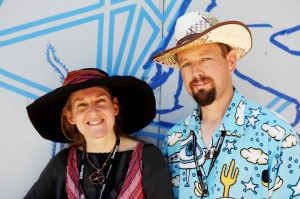
Based in Belmont, Lower Hutt with their two children Isla 13 ½ and Tarn 10, Erica and Struan strive to have a home life as well as travel the world sharing their talents.
“We were doing it full-time before we had kids. It is quite feasible if you worked internationally so as long as you didn’t mind travelling,” explains Erica.
“Since we have had kids if we were prepared to travel we would be fine but because we are trying to keep a home life we probably do it about maybe a little bit more than half a time each.
“There is a request occasionally to look a little more like everybody else at school pick up. That is a cost that any performing art kids have to pay when they have parents that do the work we do.”
You can find them on Facebook at Tape Art New Zealand and also find out all about them and their work at www.tapeart-nz.com.
